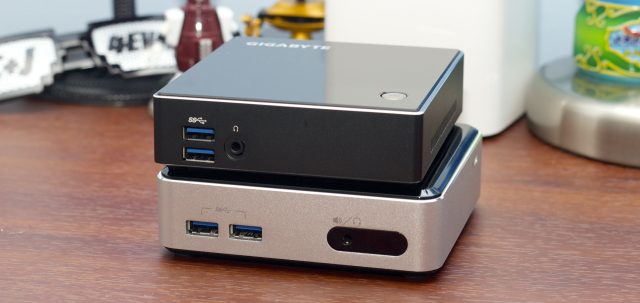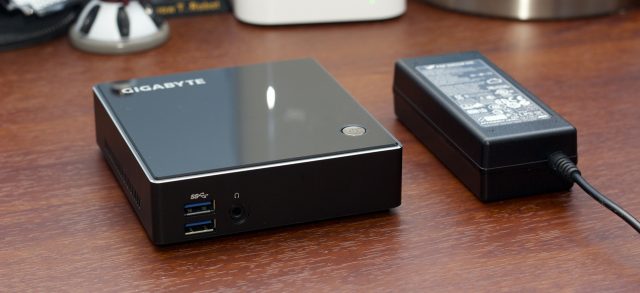
When AMD sent us the Brix Gaming for review, it wasn't alone in its box. We were also sent another, smaller Brix with an AMD processor, and it's the antithesis of its big loud cousin. It's basically the AMD take on the NUC: a small, quiet, unobtrusive little box that still tries to deliver the features and performance of a full-size entry-level desktop.
We originally planned to review both in one shot, but there was so much to say about the Brix Gaming that the GB-BXA8-5545 (say that three times fast) got edged out. Rather than bury it, we've decided to give it its own evaluation. It's the only AMD-powered desktop in the same size category as the NUC that doesn't use a wimpy netbook-class processor. And as much as Intel's integrated GPUs have improved in recent years, the name "AMD" still means something when it comes to graphics performance.
Surprise, it's a tiny cuboid!

| Specs at a glance: Gigabyte Brix GB-BXA8-5545 | |
|---|---|
| OS | Windows 8.1 x64 |
| CPU | 1.7GHz AMD A8-5545M, Turbo Boost up to 2.7GHz available with proper BIOS settings |
| RAM | 8GB 1333MHz DDR3 (supports up to 16GB) |
| GPU | AMD Radeon 8510G (integrated) |
| HDD | 128GB Crucial M500 mSATA SSD |
| Networking | 2.4GHz 802.11n Wi-Fi, Bluetooth 4.0, Gigabit Ethernet |
| Ports | 4x USB 3.0, 1x mini DisplayPort 1.2, 1x HDMI 1.4a, audio |
| Size | 4.24” x 4.5” x 1.18” (107.6 x 114.4 29.9 mm) |
| Other perks | Kensington lock, VESA mounting bracket |
| Warranty | 1 year |
| Price | $249.99 (barebones), $494.97 with listed components and software |
The other Brix boxes we've reviewed have been larger and more powerful machines, but the smaller Intel and AMD-based Brixes are a lot more like the original Intel NUC. This one's a short, square little device that's actually a little shorter than the NUC. It's an understated all-black system with matte metal sides and a glossy plastic top, and while it has an external power brick it doesn't add much to the total size of the package. With the adapters, it's roughly the size you'd get with standard PC laptops and Ultrabooks, since the Brix uses low-voltage mobile parts rather than full-fledged desktop chips.
The standard complement of mini PC ports are lined up on the front and the back: a total of four USB 3.0 ports, a mini DisplayPort, a full-size HDMI port, a gigabit Ethernet jack, a headphone jack, and a Kensington lock slot are all available. The box comes with a single-band 802.11n Wi-Fi mini card, but you'll have to supply your own RAM (it has two slots for DDR3 and you'll want to populate both with a matched set to maximize your memory bandwidth and graphics performance) and mSATA SSD. Our two 4GB RAM sticks and 128GB Crucial M500 SSD will add about $145 to the $250 base price, and you should add another $100 or so for an OEM license of Windows 8.1 if that's the operating system you want to use.
-
The single, reasonably quiet fan that keeps the AMD processor cool.Andrew Cunningham
-
The Brix has the same ports as most other mini PCs, including a full-size HDMI port (the NUC's is mini HDMI).Andrew Cunningham
-
The smaller AMD Brix box compared to the Brix Gaming.Andrew Cunningham
-
The NUC and the Brix.Andrew Cunningham
A single fan mounted to the top of the system board expels heat out the back of the system. After the noisiness of the Brix Pro (under load) and the Brix Gaming (literally all the time), we were pleasantly surprised by how quiet it was. It's near-silent while browsing the Internet or watching videos, and even when doing more CPU- or GPU-intensive tasks the fan is audible but unobtrusive.
Power consumption
This AMD Brix box uses a quad-core AMD A8-5545M (codename "Richland"), a mobile CPU with a base clock speed of 1.7GHz. The chip also supports a Turbo clock speed of up to 2.7GHz, but these speeds are only achievable if you tweak a setting in the BIOS (go to "CPU settings" and then change "CPB mode" from "disabled" to "auto").
As in the Brix Gaming, enabling the Turbo speeds makes the fan a little quicker to spin up and increases system power consumption, but for most light tasks you'll see a substantial increase in performance (according to our benchmarks, you'll see an increase as high as 33 percent). For heavier tasks that will tax all four CPU cores for an extended period of time (exporting video, for instance), you'll see a smaller increase—in our CPU stress testing, the clock speed eventually settled to about 1.84GHz, just a little bit faster than the normal 1.7GHz.
| Activity | Haswell NUC | Ivy Bridge NUC | AMD Brix | AMD Brix, Turbo |
|---|---|---|---|---|
| Off/Hibernated | 0.5W | 1.6W | 2.4W | 2.4W |
| Sleep mode | 1.1W | 2.1W | 2.9W | 2.9W |
| Idle at desktop | 6.4W | 10.8W | 11.2W | 11.7W |
| Watching YouTube in Chrome | 9.0W | 14.0W | 14.8W | 15.7W |
| Bioshock Infinite benchmark | 38.0W | 31.0W | 35.3W | 37.4W |
| Prime95 CPU torture test | 29.7W | 26.6W | 32.0W | 43.8W (peak), 36.5W (sustained) |
AMD's idle power consumption isn't as good as Intel's, due in part to Haswell's focus on low idle power usage and Intel's manufacturing advantage (Haswell is made on a 22nm processor, where Richland is 32nm). This chip compares pretty well with previous-generation Ivy Bridge parts, though, and overall it should be better behaved than the A8-5557M in the Brix Gaming (a 35W TDP CPU, where this CPU has a 19W TDP).
reader comments
54